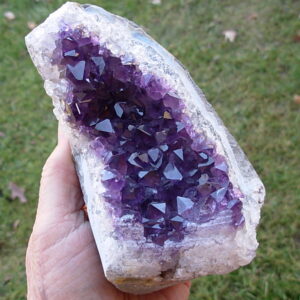Amethyst
Amethyst is mother nature’s classy version of a quartz crystal!
They are visually stunning and have been in demand for many centuries. Its name derives from the Greek "amethystos", which means "not drunken", as Amethyst in ages past was thought to ward off drunkenness. This gemstone is also said to protect its wearer against seduction. Moses described it as a symbol of the Spirit of God in the official robes of the High Priest of the Jews. If this stone were not so readily available it would be extremely expensive based upon demand.
The color of some Amethyst may slowly fade upon constant exposure to light. Amethyst changes color when it is heated. Amethyst is sometimes heat treated to deepen its color, or to transform it into Citrine. The color of certain varieties can change to a light green color, which is called "Prasiolite". Smoky colored stones can be transformed to a yellow to brownish-red and clear ones may become yellow. The natural geothermal heating sometimes creates multi-color stones, like the specimens found in Bolivia, a variety called Ametrine.
Brazilian Amethyst crystals are attractive to look at and form in drusy coatings that line the inside of sometimes large volcanic pockets or “vugs”. Some of the vugs form from trees that were engulfed in a lava flow while other vugs are gas bubbles trapped in the lava. Brazilian vugs can be very large and form crystals that are pale lavender to dark purple in color. The quality of these for gemstones is not as good as others due to the fact that the color is not consistent throughout the crystal but is on the outer surfaces and on the tops of the crystals. Most clusters form with gray, white and blue agate and have a green exterior on the vugs. Inclusions of calcite and cacoxenite are common.
African Amethyst crystals are usually large but not as attractive as Brazilian Amethyst. However, the interior color and clarity are excellent and polished slices and carvings as well as many gemstones from Africa are prized and admired. Colors range from very pale lavender to a very dark purple. Most of the South African Amethyst is formed in vugs of white or tan, to light grey basalt.
Uruguay Amethyst from the Artigas area is the most sought after locale. The specimens from Artigas are more pure and a deeper, richer color than most finds. Artigas amethyst is found as vugs deep in hard rock base and requires major excavation to find the geode like vugs of amethyst. Until 1999 this amethyst was hand dug or excavated with small machinery. Specimens have been sold through Idar-Oberstein German markets for many years.
Amethyst from Uruguay
-
Amethyst Crystals in Matrix from Uruguay 1
$54.00 Read more -
Amethyst Crystals in Matrix from Uruguay 2
$78.00 Read more -
Beautiful Deep Purple Uruguay Amethyst Geode 49
$97.95 Add to cart -
Beautiful Deep Purple Uruguay Amethyst Geode Plate 28
$179.00 Read more -
Beautiful purple Amethyst Geode from Uruguay 50
$79.00 Read more -
Beautiful purple Amethyst Geode from Uruguay 51
$89.00 Add to cart -
Beautiful Quartz and Amethyst Stalactite Cluster with Custom Stand
$329.00 Add to cart -
Extra Large Amethyst Heart from Uruguay 67
$279.00 Add to cart -
Large Lavender Purple Uruguay Amethyst Geode 29
$119.00 Add to cart -
Large Purple Uruguay Amethyst Geode 30
$159.00 Add to cart -
Large Purple Uruguay Amethyst Geode 31
$165.00 Read more
Amethyst from North America

Mexico Amethyst is found in Chihuahua, Durango, Guerrero and Veracruz areas. The amethyst found in the State of Veracruz is in the mountainous area near the town Las Vigas. Guerrero and Veracruz are known for high quality floater crystal specimens, while Chihuahua and Durango are best known for amethyst plates, crystals on matrix and geodes


Thunder Bay Canada Amethyst has a distinct red hematite inclusion just below the surface of the crystals or coating the outside of the points. This characteristic is unique to this locality. Crystals are normally drusy coatings that line or fill the fissures that develop in metamorphic rock during its formation. Crystal points are highly in demand and rather rare to find


The Reel Mine (aka Reel Amethyst Mine) is a classic location near Iron Station, Lincoln County, North Carolina. Specimens from this location are very hard to come by. The crystals have superb glassy luster and are very richly piled up and set off by the largest crystal forming at the top. Old Timers called this "Real Mine Amethyst", but this is more correctly referred to as Smoky Amethyst Quartz. It is basically Smoky Quartz with Amethyst Phantoms. There is a beautiful combination of smoky and amethystine hues, and the crystals have enough clarity to see this beautiful color mix. The photos are of specimens that came from a 1950 to 1978 estate collection in Spruce Pine, NC















